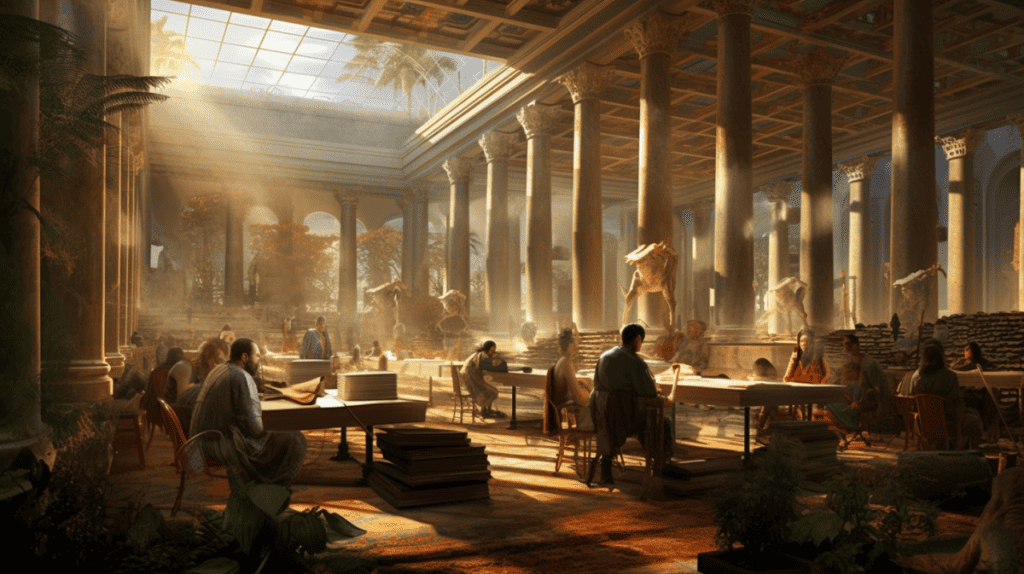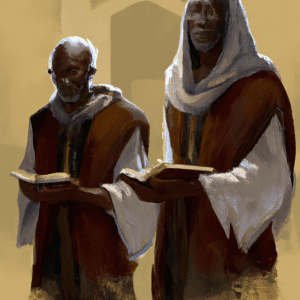The Library of Alexandria, located in ancient Egypt, was one of the world’s largest and most significant libraries. Established in the 3rd century BCE, it housed thousands of scrolls and texts. A symbol of knowledge and culture, its eventual destruction remains a subject of historical debate.
In those ancient times, the lands of Egypt, Mesopotamia, Syria, Asia Minor, and Greece were adorned with libraries and archives. These were sacred vaults of knowledge, primarily safeguarding the unique traditions and rich heritage of their local regions. However, the vision of a universal library, one that transcended borders and captured the essence of global wisdom, was a concept born from the expansive and adventurous Greek mind.

Awed by the remarkable accomplishments of neighbouring civilisations, Greek intellectuals were drawn like moths to a flame, seeking to uncover and embrace the depths of foreign knowledge. The writings of the time are filled with stories of eminent thinkers like Herodotus, Plato, Theophrastus, and Eudoxus of Cnidus journeying to Egypt, driven by an insatiable thirst for learning.
The idea of the Library of Alexandria was not merely a construct; it was a dream, a symphony of thought that resonated across cultures and epochs. A place where the pursuit of wisdom knew no bounds, where the soul of an entire civilisation yearned to know more, to understand more, and to be more. It was the embodiment of a larger worldview, a symbol of humanity’s unending quest for enlightenment.
Founding the Library of Alexandria
In the ancient echoes of time, the genesis of the Library and the Mouseion in Alexandria intertwines with the name of Demetrius of Phaleron. A once-powerful Athenian statesman and philosopher, Demetrius found solace and new purpose in the court of King Ptolemy I Soter after his political fall from grace. The king, recognising the vast intellectual treasures contained within Demetrius, entrusted him around 295 BCE with a task of extraordinary magnitude and vision: to establish the library and the Mouseion.

The “Letter of Aristeas,” penned in the 2nd century BCE, illuminates the library’s awe-inspiring mission. Demetrius was endowed with a princely budget, not merely to gather books but to pursue an unparalleled dream: to amass, if humanly achievable, all the world’s books. A Herculean task, yet Demetrius, with wisdom and determination, strove to manifest the king’s lofty aspiration (Letters 9–10).
The whispers of history repeated the same tale; Irenaeus spoke of Ptolemy’s burning desire to adorn “his library with the writings of all men as far as they were worth serious attention.” The air of Alexandria became saturated with Greek literature, the very lifeblood of scholarly pursuits in the era.
Among the library’s prized possessions were the “books of Aristotle.” Here, history’s voice wavers, providing two conflicting narratives. One tells of Athenaeus’ claim that Philadelphus acquired Aristotle’s collection for a king’s ransom. The other, narrated by Strabo, tells a twisting tale of succession and confiscation, ending in 86 BCE with Sulla’s seizure of the books, bearing them away to Rome. The confusion seems to lie in two separate realities; Athenaeus may describe the acquisition of Aristotle’s school collection in Athens, while Strabo’s words may pertain to Aristotle’s personal writings. Plutarch’s lamentation that “the Peripatetics no longer possess the original texts of Aristotle and Theophrastus” lends weight to the latter story.
In the shadowy chambers of history, the Library of Alexandria remains a symbol of human aspiration and intellect. Its foundation, entrusted to a fallen politician, blossomed into a sanctuary of knowledge, a timeless testament to the eternal thirst for wisdom. Even today, the conflicting stories of its acquisitions whisper a reminder that truth often lies shrouded in the beautiful complexities of human endeavour.
Growth of the Library
In the heart of ancient Alexandria, the Library and the Mouseion were entwined like scholars in a passionate dialogue, one nourishing the other with wisdom’s bounty. Positioned within the embrace of the royal palace and by the edge of the harbour, the library flourished under the watchful eyes of the kings, growing into a true sanctuary of research and discovery. Its connection to the Mouseion was not merely convenient; it was a poetic alignment of intellectual pursuit and resource, a symbiotic relationship that nurtured the minds seeking to unravel the universe’s mysteries.
A mere half-century after its founding in approximately 295 BCE, the Royal Library’s collection had swelled beyond the walls meant to contain it. A deluge of knowledge, a testament to human curiosity, had filled the shelves to bursting. This overflowing reservoir of wisdom prompted a grand and necessary endeavour: the creation of a branch library, a new home for the surplus volumes. Ptolemy III (246–221 BCE) answered this call by weaving the branch into the very fabric of the newly built Serapeum, located in the rich cultural tapestry of the Egyptian district south of the city.

Attempts to quantify the treasures held within the library’s walls stir the imagination and evoke a sense of awe. Early estimates from the 3rd century BCE speak of “more than 200,000 books,” a staggering collection that leaves one breathless with wonder. Later, the medieval voice of John Tzetzes paints a grander picture, chronicling “42,000 books in the outer library; in the inner (Royal) Library 400,000 mixed books, plus 90,000 unmixed books.” Still, other whispers from between the 2nd and 4th centuries CE reach an astonishing 700,000 volumes.
The numbers, though vast and varying, only hint at the true essence of the Library of Alexandria. It was a place where the quest for knowledge knew no bounds, where the heart of human inquiry beat with fervour, and where the echoes of discovery resonated through time. In this hallowed place, numbers become more than mere figures; they become a song of intellect and exploration, a symphony that continues to play in the chambers of the human soul.
Hunt for books
In the grand annals of literary history, few stories are as enchanting as the tireless pursuit of knowledge by the Ptolemies in their quest to enrich the Library of Alexandria. A fervent passion for books led them on an adventure that was filled with intrigue, cunning, and a relentless hunger for wisdom.
Legend tells of the watchful eyes that scoured every vessel sailing into the harbour of Alexandria as if searching for hidden treasure. And treasure they found, in the form of books, each a sparkling gem of human thought. These volumes were brought to the library, and a decision was made: to return them to their rightful owners or to seize them, replacing them with meticulously crafted copies. An act both audacious and reverential, this practice gave birth to an unusual collection, known fondly as “from the ships.”

The story takes another whimsical turn with Ptolemy III’s ingenious plot to acquire the sacred texts of the great dramatists Aeschylus, Sophocles, and Euripides. Guarded like rare jewels within the Athenian state archives, these texts were forbidden to leave their sanctuary. But the king’s charm and wit found a way. By depositing an exorbitant sum of silver, he was allowed to borrow them for copying. The originals, however, never returned to Athens, as the king sent back only the copies, happily forfeiting the fortune in silver. The originals had found a new home.
This unorthodox manner of the collection was enhanced by fervent purchases from book markets in Athens and Rhodes, where the library’s dedicated collectors sought out not just unique works but different versions of the same work. They gathered Homeric texts “from Chios,” “from Sinope,” and “from Massilia,” each rendition a different shade of beauty.
In a move that transcended language and culture, Egyptian wisdom was lovingly enshrined in the library. Ptolemy I, in a visionary act, encouraged Egyptian priests to gather their ancient traditions and make them accessible to Greek scholars. Figures such as the Egyptian priest Manetho, fluent in Greek, and the Greek author Hecataeus of Abdera, bridged two worlds with their writings.
The tales of the Library of Alexandria’s growth are steeped in wonder, passion, and a romance with knowledge that transcends mere acquisition. It was a dance with wisdom, a spirited chase for enlightenment, a love affair with the written word. It was a testament to the unquenchable thirst for understanding that defines the human condition, an ode to the curiosity that drives us to seek, explore, and embrace the vast tapestry of human thought.
Registration and classification of books
The meticulous preservation of knowledge within the Library of Alexandria stands as a testimony to the fervent dedication of scholars like Galen, who ensured that every detail of each book was recorded with utmost care. Each entry was a carefully penned portrait, encapsulating not only the title, author, and editor but also the birthplace of the work, its length, and the unique nature of the manuscript, whether mixed with other works or an unmixed singular text.
This system carried an inherent respect for the craft of writing, and scribes were rewarded not merely for the number of lines but for the very artistry of their craft. Under the watchful eye of Diocletian, an attempt to harmonise costs across the empire led to a structure that honoured the quality of penmanship:
– A scribe of the finest writing for 100 lines: 25 denarii
– For second-tier writing, 100 lines: 20 denarii
– To a notary for a legal document, 100 lines: 10 denarii
This structure was not simply about wages; it was an acknowledgement of the soul embedded in each stroke of the pen.

Amid the towering shelves of the library, a monumental task was undertaken by the Greek poet and scholar Callimachus. Entrusted with the daunting responsibility of cataloguing the library’s contents “in every field of learning,” his intellect wove together a bibliographical masterpiece: the Pinakes (“Tables”). Though only fragments of this work remain, they bear witness to a mind of encyclopaedic brilliance, shaping categories like rhetoric, law, epic, tragedy, comedy, lyric poetry, history, medicine, mathematics, natural science, and more.
Callimachus’s influence reverberated through time, inspiring future scholars and leaving its mark even in the dazzling 10th-century Arabic work, Ibn al-Nadīm’s Kitāb al-fihrist (“Index”).
At the heart of Alexandria’s intellectual triumph stood the Library, nourishing the minds of the Mouseion and fostering excellence across disciplines. It was a beacon of human endeavour, a monument to the relentless pursuit of wisdom. In reflecting on this extraordinary legacy, Vitruvius, in the 1st century CE, captured the gratitude that resonated across generations:
“Hence we must render to them indeed the greatest thanks because they did not let all go in jealous silence, but provided for the record in writing of their ideas in every kind.”
These words are more than a mere acknowledgement; they are a homage to the very spirit of humanity’s intellectual heritage, preserved, celebrated, and passed down through the ages, a lasting tribute to the eternal memory of mankind.
Other Languages
Within the hallowed walls of the Library of Alexandria, the collective wisdom of humanity found a home. This wasn’t merely a repository for Greek literature or Egyptian annals; it was a breathtaking tapestry woven from the thoughts, philosophies, and discoveries of myriad cultures.
In the early 3rd century BCE, the library resonated with the voice of Berosus, a Chaldean priest who penned an enthralling history of Babylonia in the poetic cadence of Greek. This work, vibrant with ancient tales, quickly found its way to Egyptian scholars, becoming a wellspring for further explorations.
Whispers of Zoroastrianism flowed through the library’s corridors, captured by Hermippus in Alexandria, who authored a tome so expansive it felt as if the very essence of a profound spiritual tradition had been crystallised on parchment.
Even the distant echoes of Buddhism reached these sacred halls, an emblem of the cultural exchange spurred by diplomatic gestures between Ashoka and Philadelphus. The library became a crossroad where East met West, a melting pot of insights and reflections.
But perhaps the most luminous gem in this treasure trove was the translation of the Pentateuch from the enigmatic whispers of Hebrew into the familiar embrace of Greek. A pressing need for the Hellenised Jewish community in Alexandria, this monumental task was undertaken with reverence and meticulous care throughout the 3rd and 2nd centuries BCE.
What emerged from this effort was the Septuagint, a translation that gleamed with the divine light of ancient texts, rendered accessible through the abundance of research material cradled within the library. It stands as a beacon in the history of translation, an artefact of immense value that continues to illuminate the path of biblical studies, guiding scholars and seekers alike.
The Library of Alexandria was not merely a collection of books; it was a symphony of human thought, a confluence of cultures and beliefs, and a living testament to the boundless curiosity and unity of the human spirit. It embraced the wisdom of the world with open arms, preserving it for posterity, and in doing so, created a legacy that still resonates with timeless and universal beauty.
Decline of the Library of Alexandria
The story of Alexandria’s great libraries remains a haunting tale, shrouded in mystery and debate, igniting the human spirit with curiosity and intrigue. These sanctuaries of knowledge, where two remarkable repositories once stood, were a symbol of enlightenment that survived generations, igniting countless minds and fostering unparalleled wisdom. Their existence remained a contentious issue until the Arab conquest of Alexandria in the 7th century. But the tide of understanding has shifted, and now a sombre consensus is emerging among scholars that both these hallowed places had fallen, lost in the mists of time, destroyed at different heartrending moments.
Who Burned the Library of Alexandria?
The exact cause of the Library of Alexandria’s destruction is debated, but multiple events over centuries may have contributed. Key culprits include: Julius Caesar’s siege (48 BCE), Theophilus (391 CE), and Theodosius I’s decree (391 CE). No single event or group can be solely blamed.
The Royal Library of Alexandria, a symbol of wisdom and learning, met an agonising demise during the throes of war. In 48 BCE, Julius Caesar, entangled in the Egyptian civil conflict between Cleopatra and her brother Ptolemy XIII. He was forced to ignite a fire that would turn the course of battle, only to inadvertently extinguish a beacon of knowledge. The words of ancient authors like Plutarch and Strabo reverberate through history, lamenting the loss of the Great Library, a repository that once guided pioneers like Eratosthenes and Hipparchus. Its destruction left an echoing silence, a void that still resonates with scholars and dreamers alike.

The daughter library, ensconced within the protective embrace of the Serapeum, lingered a while longer, a surviving relic of a world that once was. But with the sweeping zeal of Christianity across the empire, its fate was sealed. Emperor Theodosius I, consumed by his mission to obliterate paganism, unleashed a torrent of destruction. Theophilus, bishop of Alexandria, wielding the imperial decree like a sword, led the assault that shattered the Serapeum, laying low the once revered temple and its precious library. The very stones seemed to weep at the destruction, and the vivid accounts by witnesses like Theodoret, Eunapius, and Aphthonius bear testament to a loss that was both physical and spiritual.
This tragic tale did not end with the silence of the Serapeum; the echoes of devastation lingered on. A dark cloud hung over Alexandria, and the city’s intellectual life was overshadowed by the iron grip of Christianity. The once vibrant Mouseion and its libraries faded into obscurity.
The Arab conquest in 642 ushered in a new era, but with it came a strange silence regarding the legendary libraries. Centuries passed until a tantalising tale emerged in the 13th century, accusing the Arab general ʿAmr of burning the ancient Library of Alexandria. This tale, riddled with the spice of fiction, was later debunked as a fabrication, leaving historians with burning questions and a longing for the truth.
The 11th and 12th centuries, pivotal in the history of the Crusades, saw a complex interplay of cultural and military forces. Europe was awakening to a revival of classical learning, and the hunger for ancient knowledge was insatiable. Universities were springing to life, and the lust for books was voracious. In stark contrast, the Muslim East faced the tragic loss of libraries, ravaged by war and famine.
The loss of the great Fāṭimid library in Cairo, the pillaging of Tripoli’s treasures, and the personal tragedy of Usāmah ibn Munqidh, who lost his precious library, paint a picture soaked in sorrow and heartache. These tales, filled with the agony of loss, sparked public indignation, leading to a battle of words and accusations that marked the time of the Crusades.
Perhaps it was this turbulent backdrop that spurred Ibn al-Qifṭī to embrace and embellish a tale about the destruction of Alexandria’s libraries. His family’s association with the powerful Saladin might have played a role in his motivation. Saladin’s liquidation of treasures, including great public libraries, further fuels this complex and poignant narrative.
The longing for the lost treasures of knowledge transcends time and place. Europe’s thirst for ancient wisdom and the East’s profound sadness at the loss of its intellectual heritage reflects the universal human yearning for understanding and enlightenment.
As the pages of history turn, the tale of Alexandria’s libraries, with their enduring mystery and poignant loss, continues to captivate and inspire. It’s a tale that speaks to the human soul, a poignant reminder of the fragile nature of wisdom and the timeless quest for knowledge. It is a legacy that lingers, a whisper from the past that continues to stir hearts, fuel imaginations, and illuminate the ceaseless journey of the human spirit.
Related Posts
Sources
- Encyclopedia Britannica. “The fate of the Library of Alexandria.” Encyclopedia Britannica. Accessed [11.08.23]. https://www.britannica.com/topic/Library-of-Alexandria/The-fate-of-the-Library-of-Alexandria.
- Wikipedia contributors. “Library of Alexandria.” Wikipedia, The Free Encyclopedia. Accessed [11.08.23]. https://en.wikipedia.org/wiki/Library_of_Alexandria#Historical_background.





